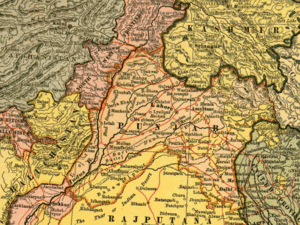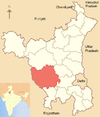Loharu
| Loharu | |
|---|---|
 | |
| Coordinates: 28°27′N 75°49′E / 28.45°N 75.82°ECoordinates: 28°27′N 75°49′E / 28.45°N 75.82°E | |
| Country |
|
| State | Haryana |
| District | Bhiwani |
| Elevation | 262 m (860 ft) |
| Population (2001) | |
| • Total | 11,421 |
| Languages | |
| • Official | Hindi |
| Time zone | IST (UTC+5:30) |
| [1] | |
Loharu (Hindi: लोहारू)(Urdu: لوہارو) is a city and a municipal committee in Bhiwani district in the Indian state of Haryana. It is the administrative headquarters of one of the 4 administrative sub-divisions of the district which comprises 119 villages.[2][3] It is also a railway junction station.
It was the seat of the eponymous princely state during the British Raj, established in 1803; and an important reminiscence of that is the Loharu Fort, now an important tourist destination of the district.
The Princely State
The princely state of Loharu, part of the Punjab States Agency was a 9 Salute state,[4] during the British Raj. It encompassed an area of 222 square miles (570 km2), and was situated in the south-east corner of the undivided Punjab province, between the district of Hissar and the Rajputana Agency.[5] In 1901, the state had a population of 15,229 people, of whom 2,175 were resident in the town of Loharu.[6]
History

The town gets its name from the Lohars or blacksmiths of the town who were employed in the minting of coins for the erstwhile Jaipur state.[7] The princely state of Loharu was founded by Ahmad Baksh Khan in 1803 when he received the town of Loharu from the British East India Company as a reward for his services against the jat rulers of Bharatpur (along with the pargana of 'Firozepur Jirka' (now in Gurgaon district) from Lord Lake).[8][9][10]

Nawab of Loharu,1884-1920.
Ahmad Baksh Khan was succeeded by his eldest son, Sams-ud-din Khan in 1827, his reign did not last long: in 1835 he was executed by the British Raj for being involved in the conspiracy to kill the British Resident to Delhi, Sir William Frazer ,[11][12] subsequently the pargana of Firozepur was taken away by the British, and the state of Loharu was given to his brother Amin-ud-din and Zia-ud-din Khan. Both were themselves kept under surveillance after the Indian Rebellion of 1857 for some time, before being released and their positions restored.
The haveli of 'Nawab of Loharu', known as Mahal Sara, lies in Gali Qasim Jan, Ballimaran, where his son-in-law, noted poet Mirza Ghalib stayed for a few years, whose own haveli lies a few yard away.[13][14] Now a gali is known as Kothi Nawab Loharu lane in Ballimaran, Chandni Chowk, Delhi.[15]
Alauddin Ahmed Khan succeeded his father Amin-ud-din Khan in 1869, and received the title of Nawab. Alauddin’s son, Amir-ud-din Ahmad Khan (1859–1937), after managing the state on his father’s behalf, succeed him in 1884, though from 1893 to 1903, he remained administrator and adviser of the state of Maler Kotla, during this time the state was being handled by his younger brother Bashiruddin Ahmed Khan, in 1903; Amir- ud-din Ahmad Khan also received the K.C.S.I honour from the British Government, and after 1 January 1903 was allowed a 9 gun personal salute, then on,[8] and later became a member of the Viceroy of India's legislative council.[6][16]

(r. 1926-1947)
In 1920, he abdicated to his second son, Aizzuddin Ahmad Khan, though he died early in 1926, leaving the state to his son, Amin ud-din Ahmad Khan (1911–1983) - the last Nawab,[17] however since the new Nawab was still young, Amirud-din Ahmad Khan stepped in and took care of the state till 1931.[18]
After the Independence of India in 1947, the state acceded unto the Union of India and many of the ruling family and the city's Muslim inhabitants re-settled in Lahore, Pakistan, though the Nawab and his direct descendants (except for the eldest daughter of Nawab Aminuddin Ahmed, Mahbano Begum who lives in Islamabad), stayed on, in India.[11]
Nawabs of Loharu
| Lineage | |||||
|---|---|---|---|---|---|
| Nawab | Reign | ||||
| Ahmad Bakhsh Khan | 1806–1827 | ||||
| Sams-ud-din Khan | 1827–1835 | ||||
| Aminuddin Ahmad Khan | 1835 - 27 February 1869 | ||||
| Allauddin Ahmad Khan | 27 February 1869 – 31 October 1884 | ||||
| Amiruddin Ahmad Khan, K.C.S.I | 31 October 1884 - April 1920 (abdicated) | ||||
| Azizuddin Ahmad Khan | April 1920 - 30 October 1926 | ||||
| Aminuddin Ahmad Khan II | 30 October 1926 – 15 August 1947 | ||||
Notable members of the Loharu clan
The ruling family of Loharu was linked by blood or marriage to several important Muslim personalities of the 19th century, including:
- Mirza Ghalib (1796—1869), renowned Urdu and Persian poet, married to Umrao Begum, daughter of Nawab Ilahi Bakhsh Khan (younger brother of the first Nawab, Ahmad Baksh Khan).
- Sir Syed Ahmed Khan, educationist KCSI [16]
- Fakhruddin Ali Ahmed (1905–1977), President of India (1974–1977)
- Ibrahim Ali Khan Pataudi (1913–1917 )Nawab of Pataudi, married to Shahar Bano Begum, daughter of a Nawab of Loharu.
Post-Independence
- The last ruling Nawab, Amin ud-din Ahmad Khan: Served in the Indian Army, seeing action during the liberation of Portuguese India in 1961. He was later elected to the Legislative Assembly of Rajasthan state, and ended his chequered career as the governor of Himachal Pradesh (1977–1981) and governor of Punjab (1981–1982).
- Ala-uddin Ahmad Khan II (Born 1938): After staying in Kolkata for many year, he now lives in Loharu town; where the Loharu fort, now in ruins, stands in its center,[19] and a major tourist attraction [20]
- Aimaduddin Ahmad Khan, or 'Durru Mian' (Born 1944) married to Fauzia Ahmad Khan: Indian National Congress politician, member Legislative Assembly of Rajasthan, Health Minster Of Rajasthan state,[21] settled in Jaipur [22]
- Noor Bano (Born 1939): Married to Syed Zulfiqar Ali Khan of Rampur, and a member 11th Lok Sabha and 13th Lok Sabha.
Loharu Descendants in Pakistan
- Jamiluddin Aali, (born 1926, Delhi), Urdu poet, playwright.[23]
- Mahbano Begum, (born 1934, Loharu), eldest daughter of Nawab Aminuddin Ahmad, married to H. E. Dr. S. M. Koreshi, Ambassador of Pakistan.[11]
- Tahira Bano.
HH Shahid Anamullah Khan married to Sahibzadi Farina Bilal of Loharu, great grand daughter of HH Nawab Mirza AIZZUDDIN AHMAD Khan Bahadur Fakhr ud-Daula [Azam Mirza].
Higher and Technical Education
There are a number of institutions of higher education located in the Loharu area. The Keystone Group of Institutions, an AICTE approved institution and offering B.Tech and MBA courses from Rajasthan Technical University, is only 5 km from the Loharu station. Loharu is just 30 km. from Birla Institute Of Technology and Science, is one of the best engineering institute in the country.It also has a premier engineering institute of the state naming Rani Jhansi Laxmi Bai Govt Polytechnic,located on Loharu-Bhiwani road. There is Govt. P.G College on Bhiwani road which offers U.G/ P.G courses and affiliated to M.D.U, Rohtak.
OTHER EDUCATIONAL INSTITUTES
One Sr. Sec School, named as Arya Sr. Sec. School is situated at village, Dhigawa Mandi, 17 K.M from Loharu, an oldest school in this area its running since 1987.
Transport
Loharu is a railway station junction on Rewari-Mahendragarh-Sadulpur railway route. It was a metre gauge track that was converted to 1,676 mm (5 ft 6 in) broad gauge in 2009. Metre gauge railway line from Loharu junction to Sikar junction, Ringas junction and Jaipur is being converted to broad gauge.
References
- Genealogy of the Nawabs of Loharu Queensland University
- Loharu 1911 Encyclopaedia Britannica
- ↑ Loharu wikimapia
- ↑ Bhiwani district Haryana Official website.
- ↑ Introduction Bhiwani district Official website.
- ↑ "salute". Royalark.net. Retrieved 2013-12-08.
- ↑ "1909 location map of Loharu in British Punjab". Zum.de. Retrieved 2013-12-08.
- ↑ 6.0 6.1 Loharu 1911 Encyclopaedia Britannica.
- ↑ Loharu Town The Imperial Gazetteer of India, 1909, v. 16, p. 170.
- ↑ 8.0 8.1 Loharu State The Imperial Gazetteer of India, 1909, v. 16, p. 169.
- ↑ Chapter 5: My Loharu Connection The Battle Within, by Brigadier Mirza Hamid Hussain, Pakistan Army 33. 1970. ISBN 969-407-286-7 -.(ebook)
- ↑ The State of Loharu Indian States: A Biographical, Historical, and Administrative Survey, by Somerset Playne, R. V. Solomon, J. W. Bond, Arnold Wright. Asian Educational Services, 2006. ISBN 81-206-1965-X.Page 691.
- ↑ 11.0 11.1 11.2 Loharu family’s get-together in capital – Islamabad Dawn, 26 May 2005.
- ↑ The Story of Many Moons ArabNews, "Sams-ud-din Khan is one of the characters in the historic novel, Kai chand thay sar-e asman (novel), by Shamsur Rahman Faruqi."
- ↑ HC fiat to Centre, Delhi Govts on poet Mirza Ghalib's haveli Indian Express, 12 April 1999.
- ↑ Delhi Hunger and History in Delhi Jauymini Barkataky, Civil Society, April 2007 Edition.
- ↑ Senior Secondary Panama Building Girls School in the Kothi Nawab Loharu lane in Ballimaran Indian Express, 8 October 2008.
- ↑ 16.0 16.1 Sir Sayyid Ahmad Khan 1911 Encyclopaedia Britannica
- ↑ Genealogy of the Nawabs of Loharu Queensland University.
- ↑ Loharu Rulers worldstatesmen.org.
- ↑ "eighth Nawab" of Loharu Alauddin Ahmed Khan The Tribune, 23 August 2007.
- ↑ Bhiwani district www.haryana-online.com.
- ↑ Nawab of Loharu
- ↑ "Heritage". Mariekesartofliving.com. Retrieved 2013-12-08.
- ↑ Jamiluddin Aali - Pakistani Poet Dawn, 5 June 2008.
Further reading
- Khandan-e-Loharu Ke Shura (Loharu Family Biography), by Hamid Sultan Ahmad. New Delhi, Ghalib Institute, 1981. (Ghalib Institute Catalogue)
- Murder of Mr. Fraser, and Execution of the Nawab Shams-ud-din - Page 86 Rambles and Recollections of an Indian Official, by W.H. Sleeman, Vincent A. Smith, Published by Asian Educational Services, 1996. ISBN 81-206-1013-X. (ebook)
- Chapter 5: My Loharu Connection The Battle Within, by Brigadier Mirza Hamid Hussain, Pakistan Army 33. 1970. ISBN 969-407-286-7 -.(ebook)
- The Yusufi Dynasty at RoyalArk.net
| |||||||||||||||||||
